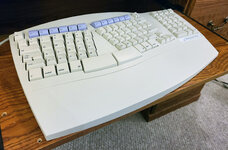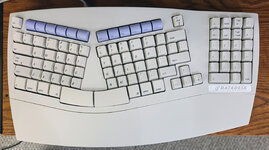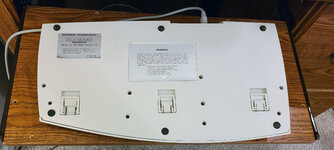[I wrote this review a year ago but never got around to taking pictures for it until now. I was inspired to write it by Drake's DataDesk TrackBoard review.]
Datadesk was a company in the 90s who made some pretty interesting keyboards such as the SwitchBoard which had three sections you could arrange in any order, the Little Big Board which was a space saver with a numpad, the TrackBoard which replaced the numpad with a trackball, and the LittleKeys which was a shrunken board for kids’ smaller hands. But the one I’ve been most interested in is the SmartBoard, because it’s combines my interests in both classic Macs and ergonomic keyboards.

With relation to classic Macs, this an ADB (or Apple Desktop Bus) keyboard. It has three ADB ports on the back: one to connect to the Mac, and two more so you can daisy chain your mouse and other peripherals. Datadesk also made PS/2 and later USB versions. Aesthetically it also complements classic Macs with its Platinum gray color (which has yellowed slightly to beige) and using a Univers Condensed Oblique font for the keycap legends (although a slightly different version from what Apple used). There are also Datadesk’s signature arched, purple function keys. The case has a gently curved top and sides meeting at sharp edges and corners. It’s peak late ‘90s peripheral design and I absolutely love the look of it.

I typed out this review on my Mac Pro using a Griffin iMate ADB to USB adapter, and every key works great in modern macOS except for caps lock, which is no biggie. I also used Karabiner-Elementals software so the function keys can be used as their equivalent macOS media keys. iMates go for stupid prices on eBay, but there are better converters made nowadays like the Drakware ADB2USB, the tinkerBOY ADB to USB, and the Big Mess o’ Wires Wombat.

Let’s talk ergonomics. There is a large integrated palm rest across the front. Under that are three two-position flip-out feet so you can negatively tilt the board to reduce wrist extension. The alphanumeric section is split into two halves angled about 23º apart to reduce wrist adduction, and the halves are tented about 7º to reduce wrist pronation.

Those are all important features, but the thing that places this board a cut above its contemporaries like the Microsoft Natural Keyboard and Apple Adjustable Keyboard is the arrangement of the keys. Instead of being in staggered rows, they are arranged in a grid. That means that, if you use proper touch-typing technique, the keys above and below the home row are directly in the natural path that your fingers take. And THAT means that you don’t have to move or stretch your fingers and hands as much to reach them, which is one of the biggest contributors to keyboard-related repetitive strain injuries. Not only that, but Datadesk went a step further and introduced splay to the middle and upper rows by using slightly wider keycaps, which follows how your fingers tend to move apart as you extend them. That’s not as important of a benefit, but it does show the amount of consideration they put into this design.
Eliminating row stagger is a crucial ergonomic feature that sadly still hasn’t caught on in mass market keyboards. Unfortunately people just don’t like to change, even when it could seriously benefit their health.

Some other layout quirks are that the =+ key has been moved to between tilde and 1, the power key is in the bottom left corner, and the navigation keys have been moved above the numpad.

Build quality seems very good. The case is all plastic but has very little flex. The board weighs about 3 lbs 2 oz, or 1.42 kg.
My one complaint about this board is with the switches. They are clicky Alps clones and they are VERY stiff, requiring about 80g of force to actuate, much heavier than I’m used to. Fortunately, because they are Alps clones, I should be able to replace the switch springs with brand new ones that are much lighter; I’ll probably go with 55 or 60g. Being clicky, they are also quite loud, giving even a Model M a run for its money. I could remove the leaf springs in the switches, but that would make them linear which I also wouldn’t like. Maybe the sound will grow on me.
Amazingly, Datadesk’s website is still online, even though it doesn’t seem to have been updated since 2001.
Overall, I really like this board and I’m glad I got it. After a spring swap, I think it may become my go-to board to use with my classic Macs.
Datadesk was a company in the 90s who made some pretty interesting keyboards such as the SwitchBoard which had three sections you could arrange in any order, the Little Big Board which was a space saver with a numpad, the TrackBoard which replaced the numpad with a trackball, and the LittleKeys which was a shrunken board for kids’ smaller hands. But the one I’ve been most interested in is the SmartBoard, because it’s combines my interests in both classic Macs and ergonomic keyboards.

With relation to classic Macs, this an ADB (or Apple Desktop Bus) keyboard. It has three ADB ports on the back: one to connect to the Mac, and two more so you can daisy chain your mouse and other peripherals. Datadesk also made PS/2 and later USB versions. Aesthetically it also complements classic Macs with its Platinum gray color (which has yellowed slightly to beige) and using a Univers Condensed Oblique font for the keycap legends (although a slightly different version from what Apple used). There are also Datadesk’s signature arched, purple function keys. The case has a gently curved top and sides meeting at sharp edges and corners. It’s peak late ‘90s peripheral design and I absolutely love the look of it.

I typed out this review on my Mac Pro using a Griffin iMate ADB to USB adapter, and every key works great in modern macOS except for caps lock, which is no biggie. I also used Karabiner-Elementals software so the function keys can be used as their equivalent macOS media keys. iMates go for stupid prices on eBay, but there are better converters made nowadays like the Drakware ADB2USB, the tinkerBOY ADB to USB, and the Big Mess o’ Wires Wombat.

Let’s talk ergonomics. There is a large integrated palm rest across the front. Under that are three two-position flip-out feet so you can negatively tilt the board to reduce wrist extension. The alphanumeric section is split into two halves angled about 23º apart to reduce wrist adduction, and the halves are tented about 7º to reduce wrist pronation.

Those are all important features, but the thing that places this board a cut above its contemporaries like the Microsoft Natural Keyboard and Apple Adjustable Keyboard is the arrangement of the keys. Instead of being in staggered rows, they are arranged in a grid. That means that, if you use proper touch-typing technique, the keys above and below the home row are directly in the natural path that your fingers take. And THAT means that you don’t have to move or stretch your fingers and hands as much to reach them, which is one of the biggest contributors to keyboard-related repetitive strain injuries. Not only that, but Datadesk went a step further and introduced splay to the middle and upper rows by using slightly wider keycaps, which follows how your fingers tend to move apart as you extend them. That’s not as important of a benefit, but it does show the amount of consideration they put into this design.
Eliminating row stagger is a crucial ergonomic feature that sadly still hasn’t caught on in mass market keyboards. Unfortunately people just don’t like to change, even when it could seriously benefit their health.

Some other layout quirks are that the =+ key has been moved to between tilde and 1, the power key is in the bottom left corner, and the navigation keys have been moved above the numpad.

Build quality seems very good. The case is all plastic but has very little flex. The board weighs about 3 lbs 2 oz, or 1.42 kg.
My one complaint about this board is with the switches. They are clicky Alps clones and they are VERY stiff, requiring about 80g of force to actuate, much heavier than I’m used to. Fortunately, because they are Alps clones, I should be able to replace the switch springs with brand new ones that are much lighter; I’ll probably go with 55 or 60g. Being clicky, they are also quite loud, giving even a Model M a run for its money. I could remove the leaf springs in the switches, but that would make them linear which I also wouldn’t like. Maybe the sound will grow on me.
Amazingly, Datadesk’s website is still online, even though it doesn’t seem to have been updated since 2001.
Overall, I really like this board and I’m glad I got it. After a spring swap, I think it may become my go-to board to use with my classic Macs.
